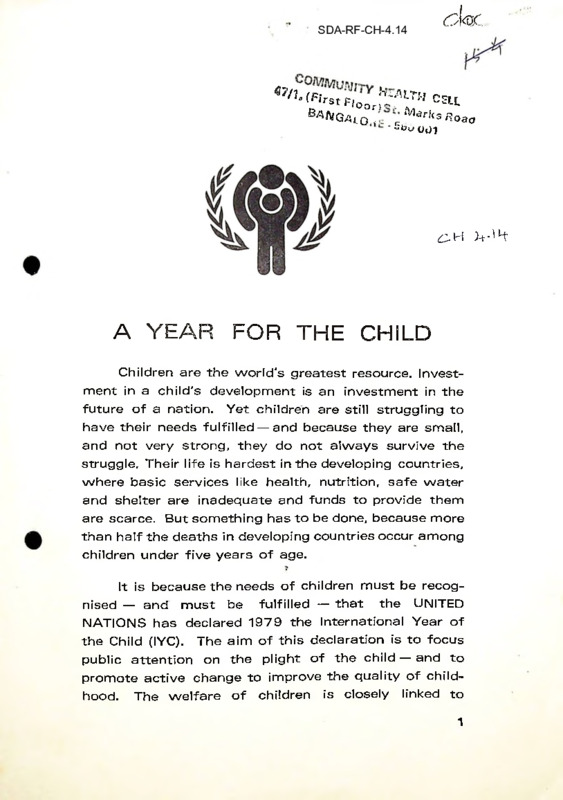SDA-RF-CH-4.14.pdf
Media
- extracted text
-
d<sc.
SDA-RF-CH-4.14
$7/1 ZEWiAfTM r.
/3’(F"-stF/Oor)„
Ll r/ cat
r /V’ar/<S fioa°
eA^GAio i
“buoo!
£H It-'H
A YEAR FOR THE CHILD
Children are the world's greatest resource. Invest
ment in a child's development is an investment in the
future of a nation.
Yet children are still struggling to
have their needs fulfilled — and because they are small,
and not very strong, they do not always survive the
struggle. Their life is hardest in the developing countries,
where basic services like health, nutrition, safe water
and shelter are inadequate and funds to provide them
are scarce. But something has to be done, because more
than half the deaths in developing countries occur among
children under five years of age.
It is because the needs of children must be recog
nised — and
must
be
fulfilled — that
the
UNITED
NATIONS has declared 1979 the International Year of
the Child (IYC).
The aim of this declaration is to focus
public attention on the plight of the child — and to
promote active change to improve the quality of child
hood.
The welfare of
children
is closely
linked to
1
economic and social progress. By dedicating a year to
the Child, the UN hopes the nations of the world will
recognise the rights of children and take action to ensure
that all children enjoy these rights.
The Purpose of the Year
The International Year of the Child (IYC) is concerned
with all children in all countries, especially young children.
Its major aims are :
—
to encourage all countries, rich and poor, to
review their programmes for the promotion of
the well-being of children, and to mobilize
support for national and local action program
mes according to each country's conditions,
needs and priorities;
—
to heighten awareness of children's special
needs among decision-makers and the public;
—
to promote recognition of the vital link between
programmes for children on the one hand, and
economic and social progress on the other;
—
to spur specific, practical measures — with
achievable goals — to benefit children, in both
the short and long term at the national level.
The Year should also provide an opportunity to
emphasize the
intellectual,
psychological
and
social
development of children, in addition to their physical
welfare.
Since 1979 is the 20th anniversary of the Declara
tion of the Rights of the Child, IYC is an opportunity
for each country to increase its efforts to implement
those rights.
2
EDUCATION : Pre-primary
and
elementary edu
cation; pre-school education for weaker sections;
mobile schools; children's literature; teachers train
ing, orientation courses for women; education of
handic'
'"raining; com
munity
SOCIZ51
es;
creches;
balwadi
for
wording
mothe
Servic
Development
LEG1SI
en's
States
enforcement
of Chi
ation on child
Acts in
labour; enaciuiem ur iaw=> <_>n ccjuaiity and non
discrimination in respect of persons born out of
wedlock.
PUBLICITY : Radio/TV programmes;
documentary
films; newspapers; printed publications; issue of
commemorative postal stamps and coins; national/
state/district/block
level
contests
for
primary/
middle/secondary school children and non school
going children.
FUND-RAISING : Creation of a national children's
fund and state level funds to raise resources for
programmes to benefit children.
National Slogan, Symbol and Theme
The Indian slogan for IYC is "Happy Child - Nation's
Pride" and the Hindi version is
— W5 W STET 1
7
The symbol depicts a boy and a girl with the sun
and a slate.
The sun signifies health and strength.
The
slate stands for the importance of education for the
future of children.
The general theme of IYC in India is "Reaching the
Deprived Child".
Cover : UNICEF Photo by S. Raman
Soti Printing Press, Delhi-6
Not viewed
